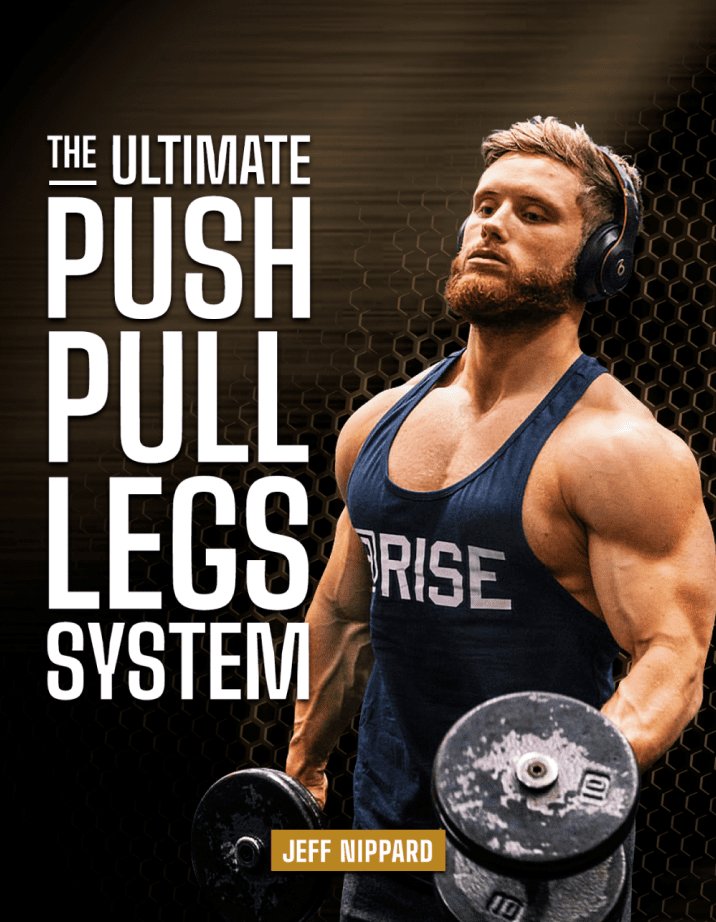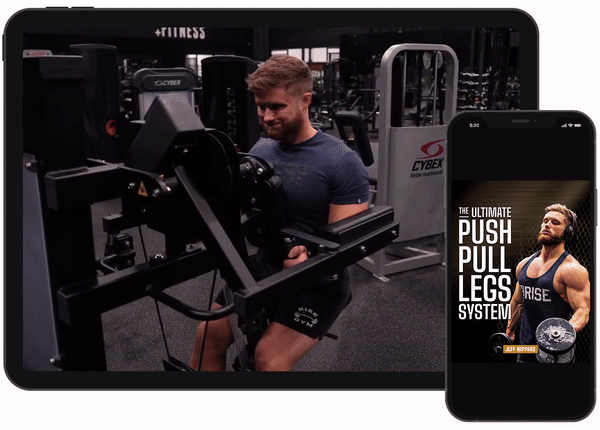
The Ultimate Push Pull Legs System
Training Split



WHAT’S NEW?

I created this training plan for intermediate-advanced trainees looking to make the absolute most out of their training. Unlike most push/pull/legs programs that are humdrum and predictable, I am calling this routine a push pull legs “system” because it is organized in a very precise and calculated way to maximize gains. Throughout this program, we’ll be borrowing from decades of sports science and years of personal experimentation to reach what I believe is the pinnacle of the PPL split.
Phase 1 is the Base Phase that uses moderate-high volume and moderate-high intensity plus a variety of advanced hypertrophy techniques to “lay the foundation” of hypertrophy.
Phase 2 is the Maximum Overload Phase where we will use low volume and ultra-high intensity to increase familiarity with true muscular failure and ensure progressive overload is occuring.
Phase 3 is the Supercompensation Phase where we will use ultra-high volume and moderate intensity to increase muscle size rapidly. A sudden, large increase in volume will provide a massive stimulus for new growth.
This is my most bodybuilding oriented program to date. We will be using a variety of cutting edge training techniques to build as much muscle in 12 weeks as humanly possible. There are over 75 exercises in this program – many of which I have never showcased anywhere before.
To ensure that strength is not neglected entirely, this program uses a minimalistic approach toward strength and an optimization approach toward hypertrophy. This means that we’ll be using just one heavy set for each of the powerlifts, plus a few back-off sets. This will be sufficient for most people to continue making strength gains while focusing almost entirely on hypertrophy. It’s also worth mentioning that while Phase 1 and 2 include all three powerlifts (squat, bench and deadlift), Phase 3 uses high rep front squats rather than back squats (*evil laugh*).
TRAINING SPLIT BREAKDOWN

Day 1 – Legs
Day 2 – Push
Day 3 – Pull
Day 4 – Rest
Day 5 – Full Body
Day 6 – RestDay 7 – Rest
* Note: Split is flexible and training days can be modified to fit your schedule
Day 1 - Push
Day 2 - Pull
Day 3 - Legs
Day 4 - Rest
Day 5 - Upper
Day 6 - Lower
Day 7 - Rest
*Note: Split is flexible and training days can be modified to fit your schedule
Day 1 - Push
Day 2 - Pull
Day 3 - Legs
Day 4 - Push
Day 5 - Pull
Day 6 - Legs
Day 7 - Rest
*Note: Split is flexible and training days can be modified to fit your schedule
WHAT’S INCLUDED

The program covers 12 weeks of training. Phase 1 of the program lasts 6 weeks, ending with a semi-deload week. Phase 2 lasts for 4 weeks. And finally, Phase 3 lasts for 2 weeks. A deload week is also included at the end of the program, so that you are ready to repeat the program or move on to a new one.

This program is NOT just an eBook. In addition to everything above, you also get a full excel sheet for recording the exact weights you use for each lift.

- Over 75 video demos by Jeff, illustrating every exercise
- Exact warmups, sets, reps, rest periods, and RPE
- Exercise substitutions for individualization
- Science explained: why the program works (+ references)
WHAT YOU WILL NEED
Gym gear is optional, as there are no required pieces of equipment to gain muscle and increase strength. With that being said, investing in some chalk or liquid chalk, a 10mm prong or lever belt, knee sleeves, squat shoes, and straps can be beneficial in allowing you to lift more weight for certain exercises.
I will most often use a lifting belt for hard working sets on the squat, bench press, deadlift and overhead press. I wouldn’t recommend wearing a belt on light warm-up sets or isolation exercises. I will use knee sleeves on squat variations and (more optionally) leg press. Chalk and straps can be very useful for improving grip issues on your deadlift and rows. However, keep in mind that straps can become a crutch for poor grip strength if overused. I don’t recommend wearing straps on warm-up sets for this reason. Many people find that an elevated squat shoe can help them get deeper on squats (especially when ankle mobility is limited) and can often improve strength via increased stability.
You can find most of my recommended equipment at the following affiliate link: http://Rise.ca/jeff

FREQUENTLY ASKED QUESTIONS
First, remember that this program is very minimal in terms of SBD volume. For the most part, you’re only doing each lift once a week for one hard set and a couple back-off sets. This amount of strength work is unlikely to interfere with your hypertrophy goals in any significant way and may actually be beneficial if it allows you to overload other lifts more effectively. Still, if you want to avoid the powerlifts altogether due to injury or preference, there are two substitution options for each lift that you can do instead of the powerlifts. After substituting the exercise, keep the sets, reps, and everything else exactly the same. This will ensure that you still get some general strength work in. For example, if the program calls for 1 set of 2 reps on the deadlift, you could substitute this for 1 set of 2 reps on either the trap bar deadlift or the barbell hip thrust.
As a second option, if you really don’t want to do any strength work at all, you can simply set a low-end rep cap at 4 reps for the entirety of the program. This means you simply won’t do any sets below 4 reps. In this case, if a set calls for 1, 2 or 3 reps, you will simply do 4 reps instead. So, for example, if the program suggests that you do 1 set of 2 reps on the deadlift, you could substitute this for 1 set of 4 reps on either the deadlift, trap bar deadlift, or barbell hip thrust. If a set calls for 4 or more reps, simply keep the reps the same. In the event that a set calls for 3-5 reps, just do 4-5 reps instead of 3-5. I wouldn’t necessarily prefer this option because I do think strength work is important. However, if you don’t want to do any strength work, there isn’t a big issue in just replacing the sets below 4 reps as explained above.
In either case, because the direct strength work is quite low in this program, this should be a very easy work-around.
Every exercise includes two substitution options, which are listed in order of preference. This means that if you can’t perform the original exercise, you should go with Substitution Option 1 first, and then Substitution Option 2, if you can’t perform Option 1.
Yes. Whether you just prefer the other exercise or it’s one you have easier access to, feel free to go with either of the Substitution Options over the original exercise. The program was designed so that all substitution options will elicit a very similar training effect. With that said, there are some intensity techniques that are better suited for specific exercises, so assuming you have access to the exercise, I would default to doing the main exercise listed before turning to the substitution options.
Each workout should take you approximately 60-90 minutes from start to finish, including the warm-up, if you adhere to the rest periods given. If you take your time with the warm-up and are more lax with rest times between sets, your workouts may take a bit longer.
Yes, to reduce the time commitment of each session, you can first try aiming for the lower end of all of the suggested rest ranges. For example, if an exercise says to rest for approximately 2-3 minutes between sets, you would rest for just 2 minutes between sets.
If this doesn’t sufficiently reduce your workout time, you can try supersetting isolation exercises within the program. For example, on Leg Day #1 of Week 1, you could superset Leg Press Toe Press with Decline Plate Crunch. In this instance, you would perform your set of Leg Press Toe Press, then transition to a set of Decline Plate Crunches, and then go back to Leg Press Toe Press to repeat this process, with minimal rest between exercises. The goal is to still get about 1 minute of rest before returning to each exercise, while the act of supersetting allows one muscle to rest while the other works.
If all of these adjustments still don’t save you enough time, you may want to consider running my Essentials Program, which was specifically designed with busy people in mind and guarantees workouts that last under 45 minutes.
Yes, but try your best to keep compound movements at the beginning of the workout and save isolation movements for the end. This is to prevent the isolation exercises from interfering with your strength on the compound lifts.
Bodybuilding is a marathon, not a sprint. It can be difficult to accurately determine if you’re making visual progress day-to-day or even week-to-week. Taking physique progress photos every 4-6 weeks and comparing them side by side is a good way to detect visual differences that you simply wouldn’t notice in the mirror. But ultimately, because of the relationship between strength gain and muscle gain, the main metric I want you to use for tracking your progress is strength. If you’re getting stronger, you’re progressing. It is strongly recommended to log every workout either in writing (print the program out or use a separate notebook) or in an app, so you don’t have to rely on memory to keep track of personal strength records. Taking body measurements a few times a year can also be helpful (arms, thigh, waist, neck) but simply focusing on steady strength progression will be your best proxy for determining muscular progress.
You will need at least an adjustable bench, dumbbells, and a pull-up bar (or bands to perform lat pulldowns) to run this program effectively. Because there are exercise substitutions included for every exercise, you can run this program with basic lifting equipment and can tailor it to fit your situation. To run the program exactly as written (without any substitutions) however, you would need gym access as there are a few cable and machine exercises included as well.
If you have any other questions, please feel free to reach out to my coaching support team at any time.

 Get This Program
Get This Program